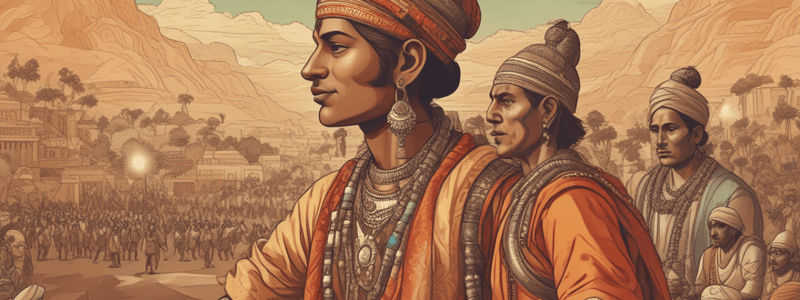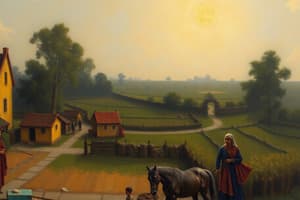Podcast
Questions and Answers
Who led the Pagal Panthis rebellion against the Zamindars and British Agents?
Who led the Pagal Panthis rebellion against the Zamindars and British Agents?
- Majnu Shah
- Fakir Uprising
- Velu Thampi
- Karam Shah, Tipu Shah (correct)
Which rebellion was a result of the British land revenue system?
Which rebellion was a result of the British land revenue system?
- Vellore Mutiny
- Fakir Uprising
- Rangpur Rebellion
- Moplah Rebellion (correct)
Who led the Kuka Rebellion against the British?
Who led the Kuka Rebellion against the British?
- Ram Singh (correct)
- Fateh Hyder
- Chittur Singh
- Bidyadhar
What was the reason for the Vellore Mutiny?
What was the reason for the Vellore Mutiny?
Which rebellion was a result of the financial burden of subsidiary Alliance?
Which rebellion was a result of the financial burden of subsidiary Alliance?
Who led the Pailkas Rebellion against the land revenue demand?
Who led the Pailkas Rebellion against the land revenue demand?
What was the reason for the Sanyasi Rebellion?
What was the reason for the Sanyasi Rebellion?
Who led the Ramosi Rebellion against the land revenue settlement?
Who led the Ramosi Rebellion against the land revenue settlement?
What was the primary reason for the Rangpur rebellion in 1783?
What was the primary reason for the Rangpur rebellion in 1783?
Which of the following was a characteristic of the tribal movements?
Which of the following was a characteristic of the tribal movements?
What was the outcome of the Indigo revolt?
What was the outcome of the Indigo revolt?
What was the primary reason for the Deccan riots?
What was the primary reason for the Deccan riots?
What was a weakness of the tribal movements?
What was a weakness of the tribal movements?
What was a result of the Pabna revolt?
What was a result of the Pabna revolt?
What was a reason for the Rangpur rebellion, Indigo revolt, and Pabna revolt?
What was a reason for the Rangpur rebellion, Indigo revolt, and Pabna revolt?
What was a strength of the tribal movements?
What was a strength of the tribal movements?
Which of the following tribal movements was a response to the British policies of recruiting labor during the First World War?
Which of the following tribal movements was a response to the British policies of recruiting labor during the First World War?
Which of the following tribal movements was led by Jadonang?
Which of the following tribal movements was led by Jadonang?
What was the primary reason behind the peasant revolts in India during the colonial period?
What was the primary reason behind the peasant revolts in India during the colonial period?
Which of the following tribal movements took place in the 1820s?
Which of the following tribal movements took place in the 1820s?
Which of the following tribal movements was a response to the occupation of the hilly region?
Which of the following tribal movements was a response to the occupation of the hilly region?
What was the main limitation of the rebellions before 1857 in India?
What was the main limitation of the rebellions before 1857 in India?
Which of the following tribal movements took place in Tripura?
Which of the following tribal movements took place in Tripura?
What was the common demand of the tribal rebellions in India during the colonial period?
What was the common demand of the tribal rebellions in India during the colonial period?
Which of the following tribal movements was led by Gaidinliu?
Which of the following tribal movements was led by Gaidinliu?
What was the impact of colonial policies on the Indian countryside?
What was the impact of colonial policies on the Indian countryside?
Why did the rebellions and revolts in India often falter or stop?
Why did the rebellions and revolts in India often falter or stop?
Which of the following tribal movements was a response to the hike in House Tax rates?
Which of the following tribal movements was a response to the hike in House Tax rates?
What was the primary target of the rebellions in India during the colonial period?
What was the primary target of the rebellions in India during the colonial period?
Which of the following tribal movements took place in the 1930s?
Which of the following tribal movements took place in the 1930s?
What was the impact of commercialization on Indian peasants during the colonial period?
What was the impact of commercialization on Indian peasants during the colonial period?
What was the nature of the resistance movements in India during the colonial period?
What was the nature of the resistance movements in India during the colonial period?
Flashcards
Rebellions (British India)
Rebellions (British India)
Rebellions against British officers or agents due to colonial policies.
Peasant Rebellions
Peasant Rebellions
Rebellions against economic policies and agents created in agriculture.
Tribal Rebellions
Tribal Rebellions
Rebellions against colonial forest policy and agents of colonialism.
Impact of Land Revenue Settlements
Impact of Land Revenue Settlements
Land revenue settlements contributed to poverty and the destruction of the countryside.
Signup and view all the flashcards
Strengthening of Intermediaries
Strengthening of Intermediaries
The increasing powers given to landlords and moneylenders.
Signup and view all the flashcards
Commercialization of Agriculture
Commercialization of Agriculture
Pressured adoption of British-suggested crops for market purposes.
Signup and view all the flashcards
Limited Understanding of Colonialism
Limited Understanding of Colonialism
A limited grasp on the complete colonial structure, often only opposing local agents while still appealing to the British state.
Signup and view all the flashcards
Localized Nature of Rebellions
Localized Nature of Rebellions
Rebellions confined to specific areas addressing local concerns.
Signup and view all the flashcards
Sanyasi Rebellions (1763-1820)
Sanyasi Rebellions (1763-1820)
A rebellion against attempts to stop their mobility.
Signup and view all the flashcards
Fakir Uprising (1763-1820)
Fakir Uprising (1763-1820)
Uprising against restrictive mobility policies.
Signup and view all the flashcards
Pagal Panthis (1763-1820)
Pagal Panthis (1763-1820)
Rebellion against landlords and British Agents.
Signup and view all the flashcards
Moplah Rebellion
Moplah Rebellion
A rebellion against the British land revenue system.
Signup and view all the flashcards
Vellore Mutiny (1806)
Vellore Mutiny (1806)
Rebellion against removal of caste privileges and markers.
Signup and view all the flashcards
Velu Thampi Rebellion (1809)
Velu Thampi Rebellion (1809)
Rebellion against the financial burden of subsidiary alliance.
Signup and view all the flashcards
Pailkas Rebellion (1817)
Pailkas Rebellion (1817)
Rebellion against land revenue demand for rent-free land.
Signup and view all the flashcards
Rangpur Rebellion (1783)
Rangpur Rebellion (1783)
Rebellion against Ijardari system and exploitation.
Signup and view all the flashcards
Indigo Revolt (1859-60)
Indigo Revolt (1859-60)
Revolt against coercive practices of planters.
Signup and view all the flashcards
Deccani Riots (1857)
Deccani Riots (1857)
Riots against moneylenders and cotton prices.
Signup and view all the flashcards
Panna Rebellion (1857)
Panna Rebellion (1857)
Rebellion against landlords and exploitation.
Signup and view all the flashcards
New Land Revenue System
New Land Revenue System
New Land Revenue System caused peasant uprisings.
Signup and view all the flashcards
Ruin of Handicrafts
Ruin of Handicrafts
The overcrowding of land due to the deindustrialization ruining handicrafts.
Signup and view all the flashcards
Colonial Forest Policy
Colonial Forest Policy
Colonial forest policy was a reason for Tribal Movements.
Signup and view all the flashcards
Exploitative Agents
Exploitative Agents
Influx of exploitative agents (money lenders and Zamindars).
Signup and view all the flashcards
Forest Resource Access
Forest Resource Access
Non-accessibility to forest resources was a reason for tribal movements.
Signup and view all the flashcards
Tribal Identity
Tribal Identity
Tribal identity was a strength of tribal movements.
Signup and view all the flashcards
Limited unity
Limited unity
Different tribal identities limiting unity and coordination.
Signup and view all the flashcards
Ahoms Revolt (1828-33)
Ahoms Revolt (1828-33)
A revolt against non-fulfillment of pledges by the British government.
Signup and view all the flashcards
Khasis Revolt (1830)
Khasis Revolt (1830)
A revolt against the occupation of the hilly region.
Signup and view all the flashcards
Kukis Revolt (1917-19)
Kukis Revolt (1917-19)
Rebellion against British policies of recruiting labor during World War I.
Signup and view all the flashcards
Zeliangrong Movement (1920)
Zeliangrong Movement (1920)
Movement against the failure of British to protect them during the Kuki violence.
Signup and view all the flashcardsStudy Notes
Tribal and Peasant Movements in India
Rebellions, Peasant Revolts, and Tribal Revolts
- Rebellions targeted British officers or agents due to colonial policies
- Peasant rebellions were against economic policies and agents created in agriculture
- Tribal rebellions were against colonial forest policy and agents of colonialism
Reasons for Rebellions
- Land revenue settlements leading to poverty and destruction of countryside
- Strengthening of powers of landed intermediaries (landlords and money lenders)
- Commercialization and forced adoption of British suggested crops
- Famines and food shortages
- Colonial policies and administrative machinery affecting people
Problem with Rebellions
- Limited understanding of colonialism, targeting agents but seeking redressal from the British state
- Localized nature, remaining within their own territory and not going beyond local issues
- Easily diluted or stopped with concessions from the British colonial system
Examples of Rebellions
- Sanyasi Rebellions (1763-1820) against British attempts to stop their mobility
- Fakir Uprising (1763-1820) against mobility restrictions
- Pagal Panthis (1763-1820) against Zamindars and British Agents
- Moplah Rebellion against British land revenue system
- Kuka Rebellion (1840-45) against Sikh loss of territory and humiliation
- Vellore Mutiny (1806) against removal of caste privileges and markers
- Velu Thampi Rebellion (1809) against financial burden of subsidiary alliance
- Pailkas Rebellion (1817) against land revenue demand for rent-free land
Peasant Uprisings
- Rangpur Rebellion (1783) against Ijardari system and exploitation
- Indigo Revolt (1859-60) against coercive practices of planters
- Deccani Riots (1857) against money lenders and cotton prices
- Panna Rebellion (1857) against landlords and exploitation
Reasons for Peasant Uprisings
- Colonial economic policies, land revenue settlement, commercialization, and deindustrialization
- New land revenue system
- Ruin of handicrafts leading to overcrowding of land
- Colonial administrative and judicial system
Tribal Movements
- Reasons for Tribal Movements:
- Colonial forest policy
- Influx of exploitative agents (money lenders and Zamindars)
- Non-accessibility to forest resources
- Taking away forest resources
- Strengths:
- Localized nature
- Local issues
- Tribal identity
- Easy mobilization
- Weaknesses:
- Different tribal identities limiting unity and coordination
- Localized nature
- Limited knowledge of colonialism
- Lack of unity
- Primitive weapons
Examples of Tribal Movements
- Ahoms Revolt (1828-33) against non-fulfillment of pledges by the British East India Company
- Khasis Revolt (1830) against occupation of the hilly region
- Singphos Rebellion (1830s) against British rule
- Kukis Revolt (1917-19) against British policies of recruiting labor during World War I
- Revolt in Tripura (1863, 1942-4, 1920) against hike in House Tax rates and settlement of outsiders
- Zeliangrong Movement (1920) against the failure of British to protect them during the Kuki violence
- Naga Movement (1905-31) against British rule and for setting up of a Naga Raj
- Heraka cult (1930) against British rule and suppression
Studying That Suits You
Use AI to generate personalized quizzes and flashcards to suit your learning preferences.




